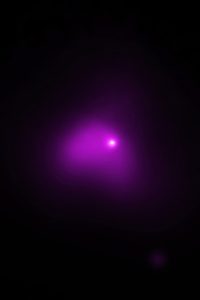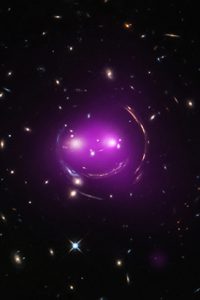
From the February 2016 Desktop News | When Dr. Jimmy Irwin, a professor in the Department of Physics and Astronomy, began his research on the Cheshire Cat group of galaxies, he was interested in more than just the teasing smile of a disappearing cat.
“The two bright eye galaxies,” Irwin said, “are actually moving very fast relative to one another, so I thought this may be a collision between two groups.”
And if there was a collision, the new galaxy would be big and bright enough to form what scientists call a fossil group, or a group of galaxies in which the biggest galaxy is several times brighter than the ones surrounding it.

Irwin collaborated with UA professor of physics and astronomy Raymond E. White III, former UA postdoctoral researcher Peter Maksym, and others on the project. Their findings were published in The Astrophysical Journal in June 2015.
The idea that fossil groups have formed in the recent past and will continue to form is fairly new. Originally scientists assumed that fossil groups were ancient cosmic artifacts, orbiting through the universe long enough that they were able to collide with and cannibalize all of their larger neighbors. Using computer simulations, scientists have now proved that these groups can actually be relatively young. But until Irwin and his team, no one had gone through the trouble of proving it observationally.
In order to prove his theory that the Cheshire Cat cluster will become a fossil group, Irwin needed more than just an optical Hubble image. The Cheshire Cat is far away, nearly 4.6 billion light years, and because the light that scientists currently see from it is as old as the earth itself, Irwin won’t be able to prove his theory optically for another 1 billion years.

Visual light, however, isn’t the only way to see across space. NASA’s Chandra X-ray Observatory has a telescope that reads x-ray emissions, which indicate extreme levels of heat. Irwin received a grant from Chandra to look at the space between the eye galaxies. While the galaxies themselves wouldn’t emit enough heat to show up on an x-ray image, a collision between them would. Sure enough, the x-ray image shows a bright purplish cloud, indicating that the galaxies have begun to collide. In a billion years, they will have merged completely.
On the tails of this discovery, Irwin’s doctoral student Lucas Johnson began a search for more of these fossil-group progenitors throughout the universe. Johnson received a $150,000 grant for his research, which allows him to use both Hubble and Chandra telescopes. He has already found nearly two dozen other progenitor groups—and suspects there are many more.